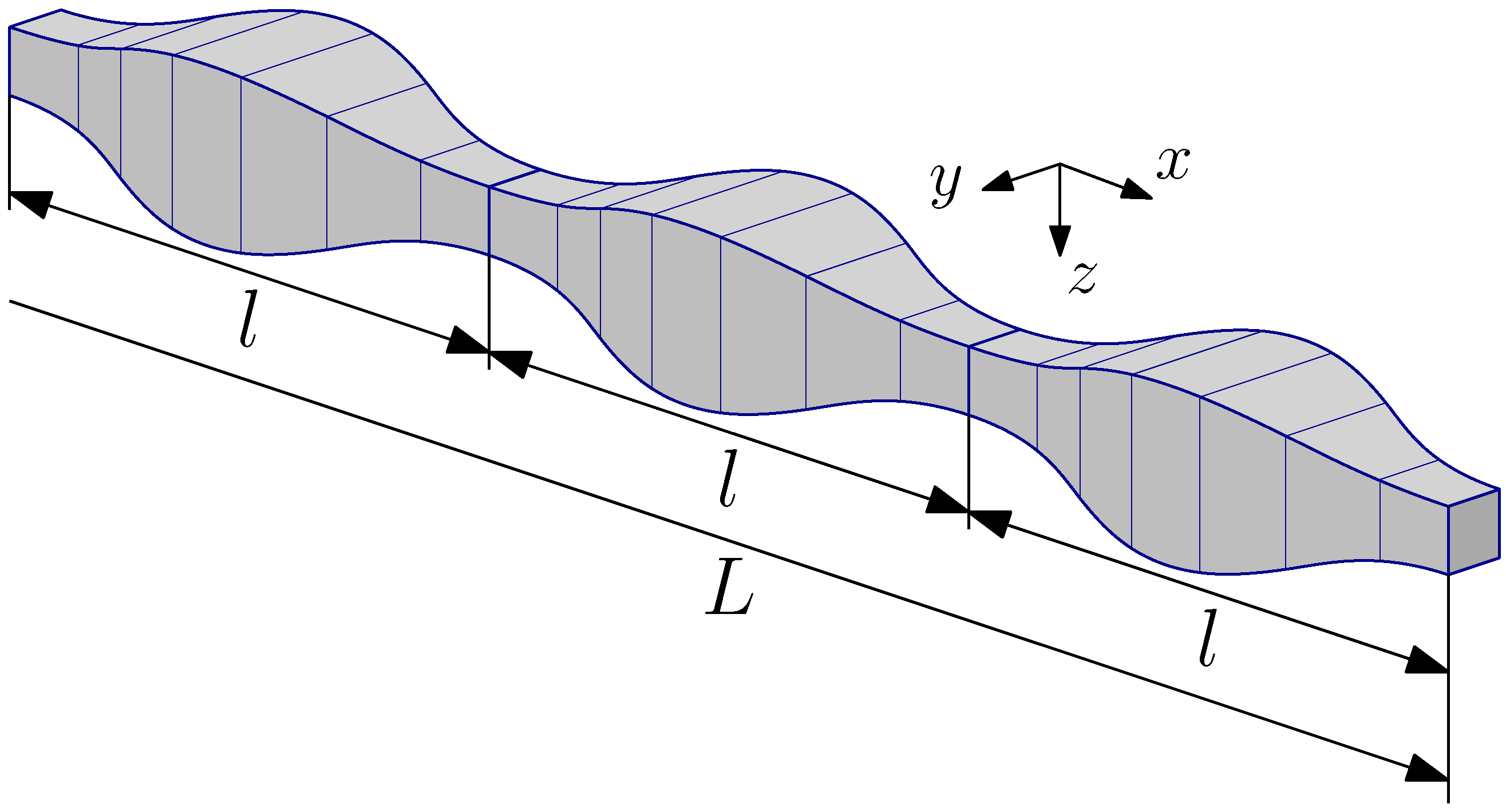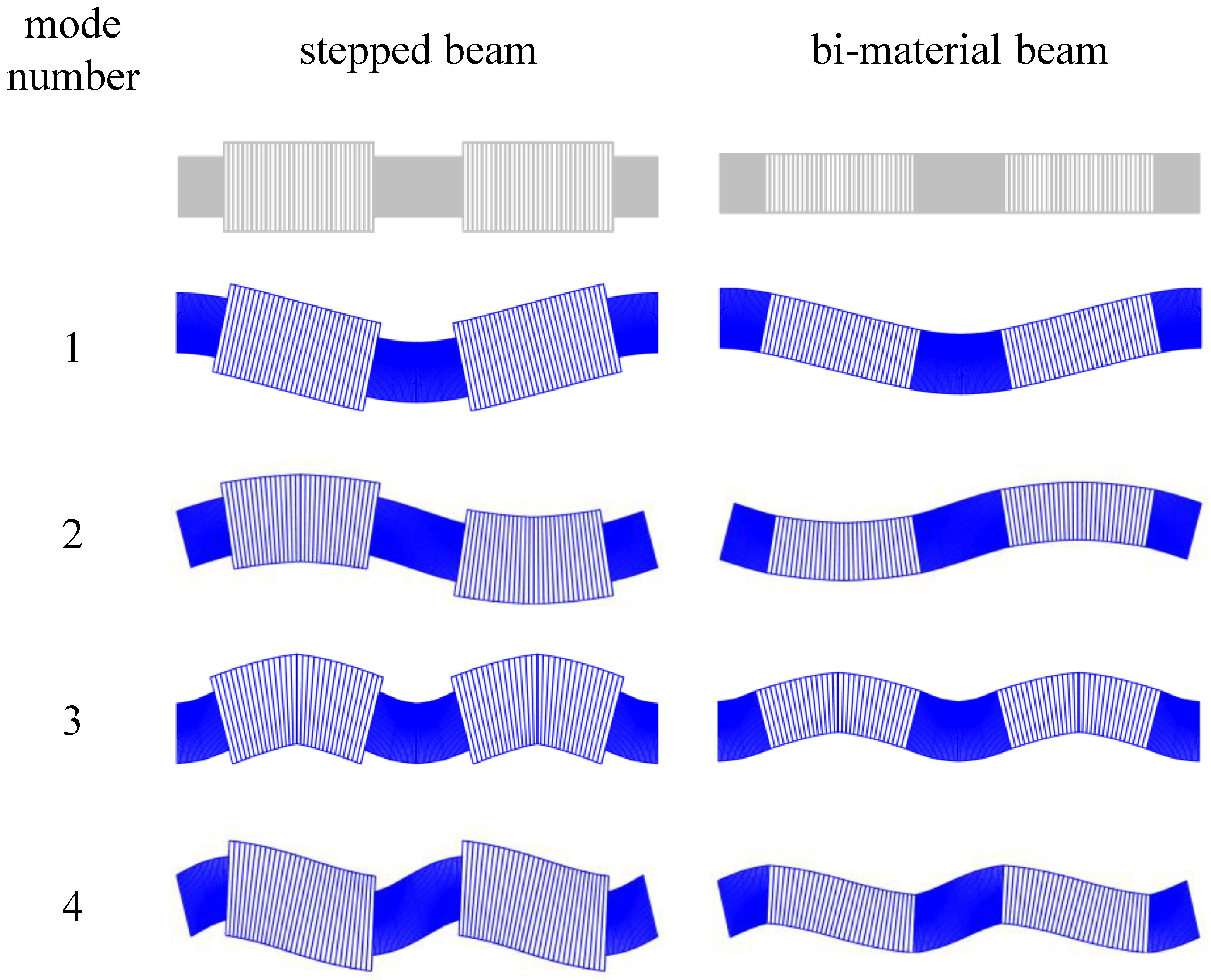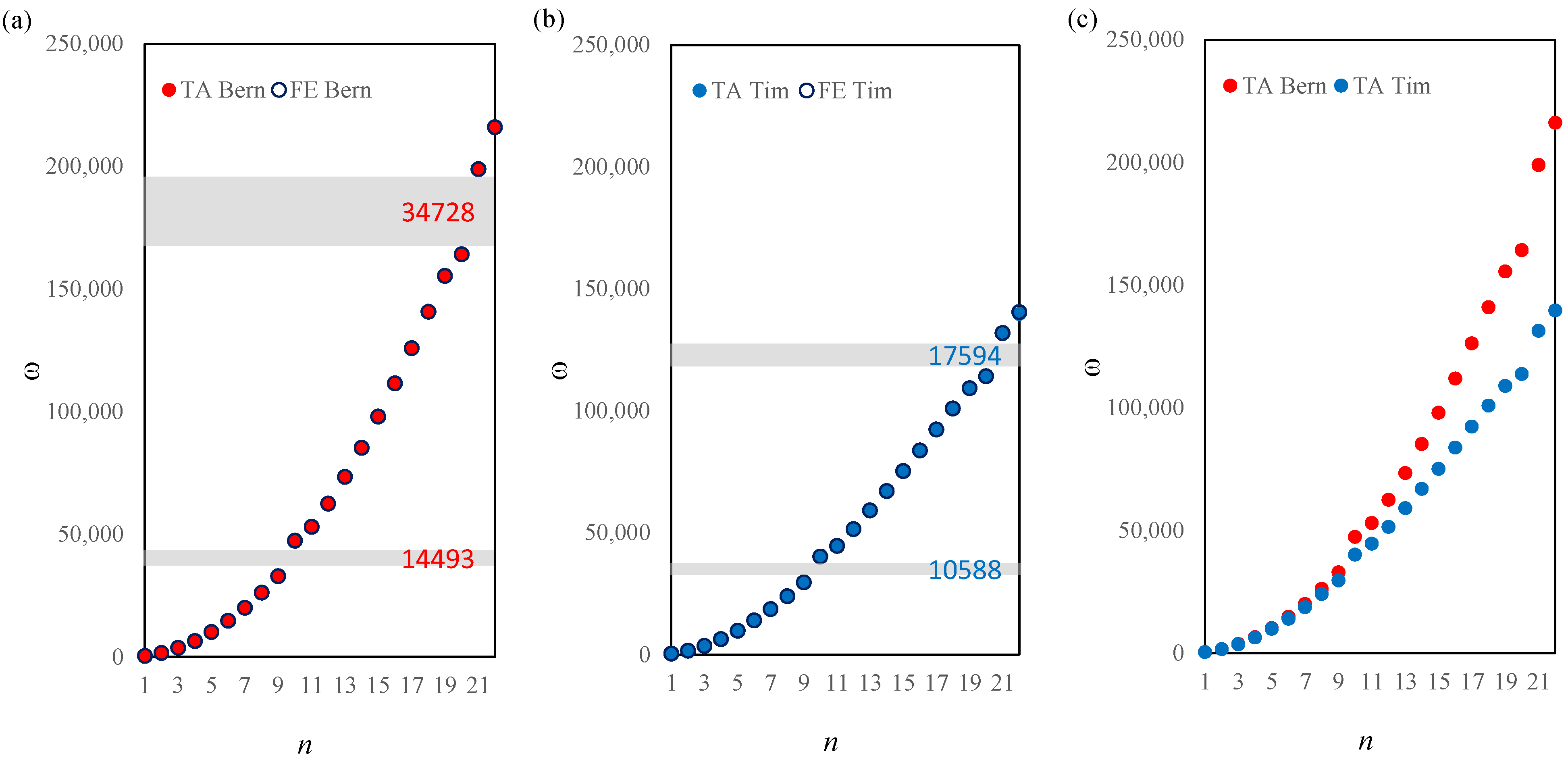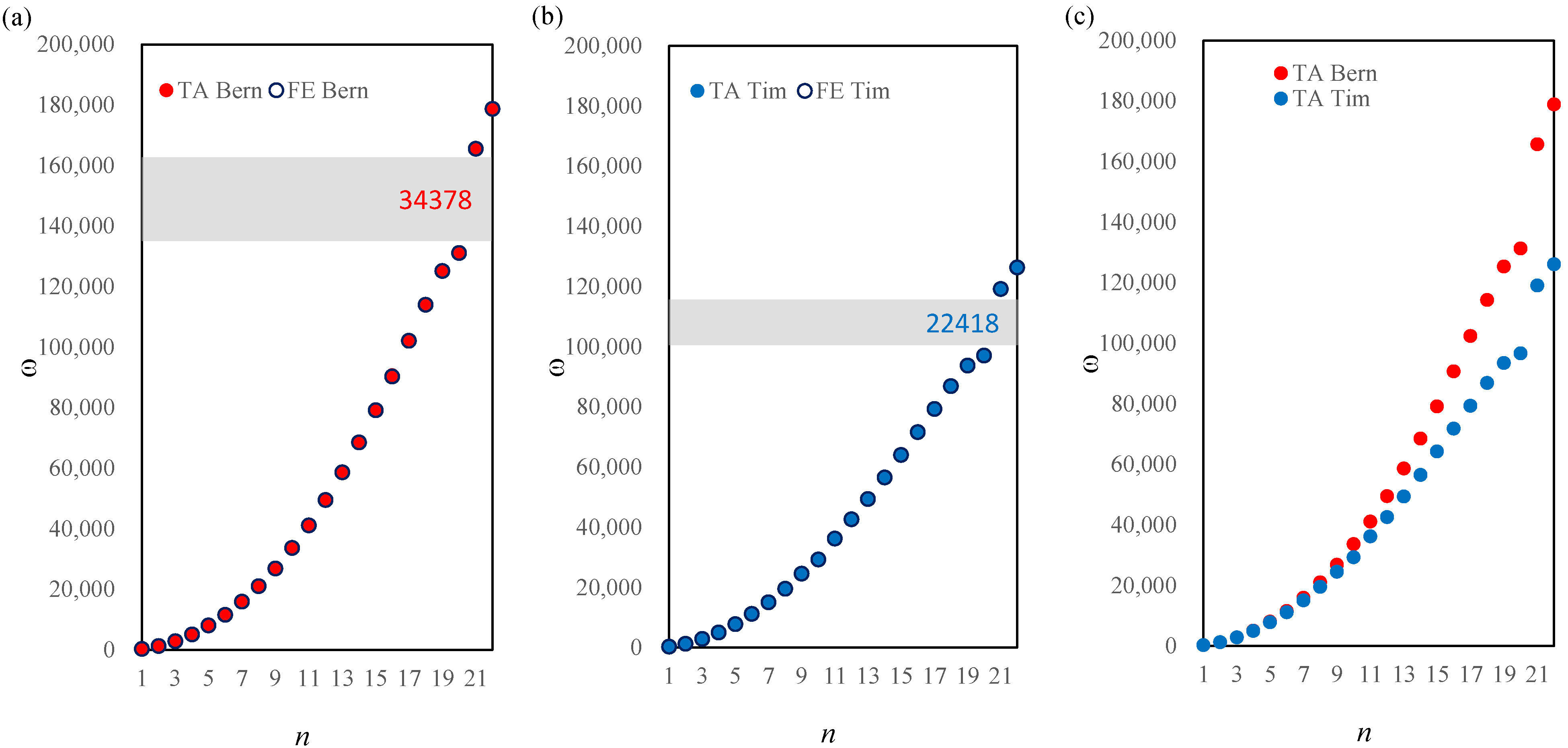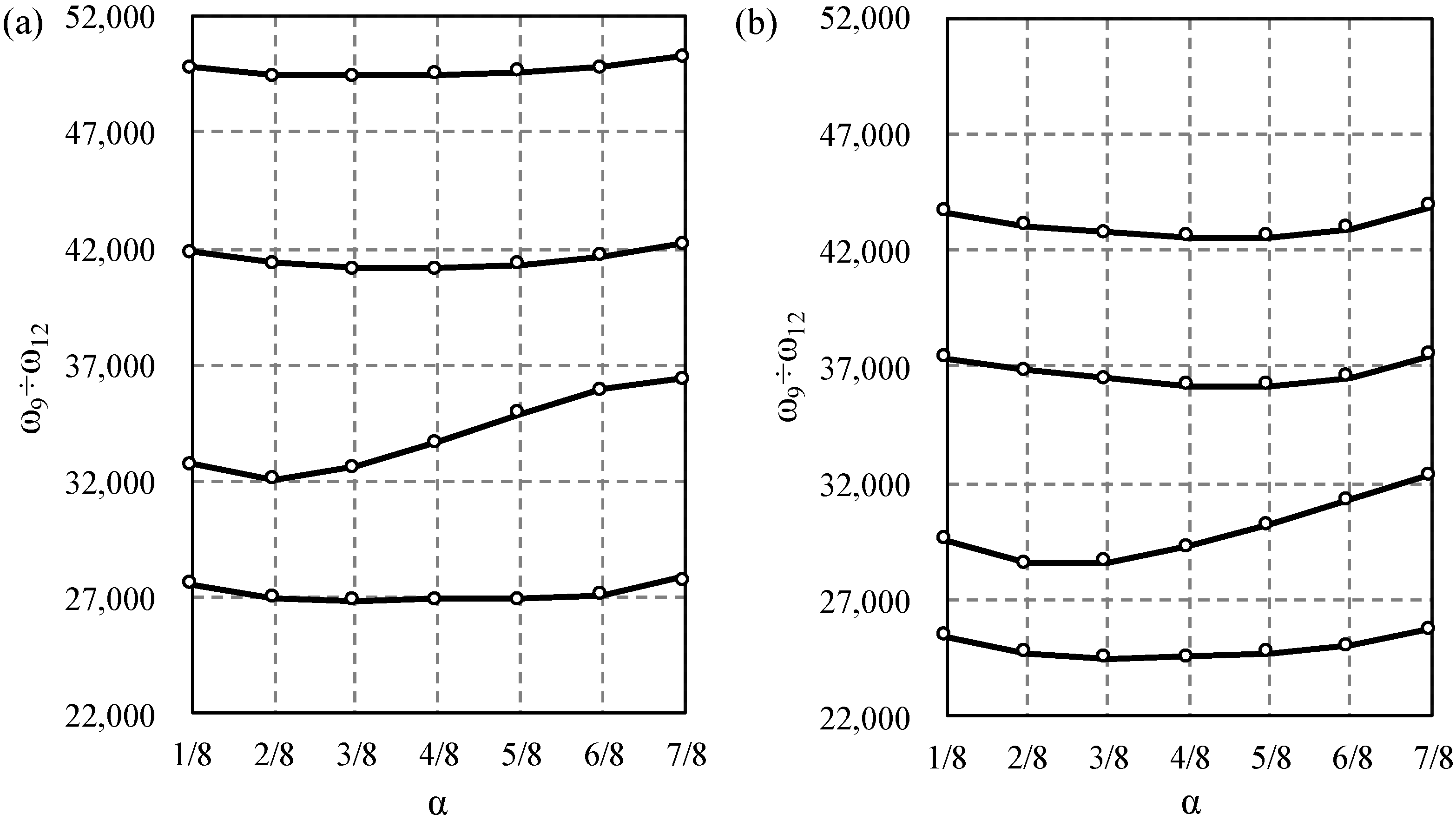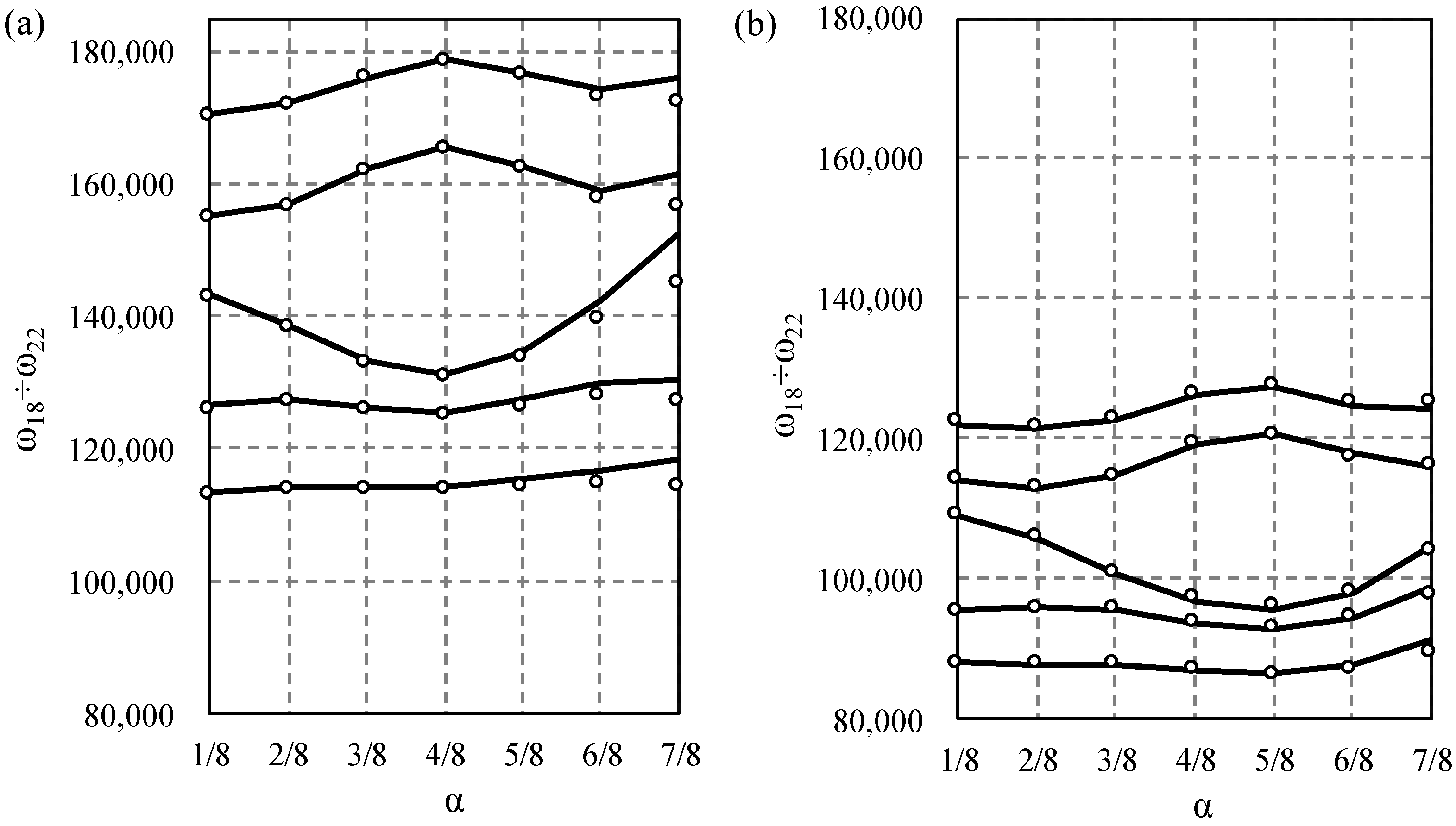1. Introduction
Here, the considered periodic beams consist of repeated identical segments made from two or more different materials or segments made of a single material but with a variable cross-section dimensions or shape. Such structural elements possess certain distinguishing dynamic features, such as the existence of gaps in the frequency spectrum. The very mechanism of the gap occurrence in finite beams is clear. It is caused by the periodic distribution of the stiffness and mass properties that tends to favour certain vibration shapes and, as a result, the corresponding frequencies.
More precisely, as every mode shape consists of a finite number of half-waves, it is important if the mode shape nodes or antinodes are close or overlap with maximum or minimum stiffness and mass points. As a consequence, the frequency gaps for a simply supported beam are expected near frequencies for which the corresponding number of half-waves n is an even multiple or divisor of number of cells (for an even number of cells) or (for an odd number of cells).
This paper focuses on linear-elastic beams with a periodic structure considered in the framework of the Euler–Bernoulli (abbreviated: Bernoulli) and Timoshenko–Ehrenfest (abbreviated: Timoshenko) theories. Generally speaking, the former of these theories has its application limited to analysis of slender beams, as it is a special case of the latter. The second theory takes into account both shear deformations and rotatory inertia effects, which makes it suitable for the analysis of moderately thick beams.
Many interesting remarks about these theories and their applications in the analysis of stepped beams can be found in the works [
1,
2,
3,
4,
5,
6], the first of which draws attention to the authorship of the so-called Timoshenko theory. There are many engineering fields in which multiple-stepped beams can be applied.
Structures, such as aircraft wings, long span truss and beam bridges, suspended pipelines and rotatory unbalanced shafts can be approximately represented as such. For example, high buildings made from repetitive floors can be modelled as clamped beams with effective cross-section and equidistant lumped masses. There are other problems, such as periodically damaged structures, e.g., cracked reinforced concrete beams. In many of these domains, high-frequency vibrations are of crucial importance. Future applications are in the fields of vibration control and acoustic insulation.
Thus, it is desirable to develop efficient methods to make the analysis of low and high frequencies of these structures possible. The question arises: can an averaged model yield correct results for such non-continuous structures? The answer to this question can be pursued in various ways, including through numerical experiments as presented in this paper.
Dynamical problems of beams with periodic distributions of material and geometric properties are governed by differential equations with highly oscillating, often non-continuous coefficients. There are various ways to tackle this problem. One group of these methods is based on discretization by means of the Finite Element Method, Finite Difference Method, or others. The second group strives to obtain simplified models, often based on homogenization. The resulting models replace the original, non-homogeneous structure with an equivalent homogeneous one with effective constant or slowly varying properties.
Among them, the theory of asymptotic homogenization [
7] is one of the most popularized due to its mathematical rigorousness. However, these models often neglect the effect of the periodicity cell size, which is sufficient in the static analysis of such structures. In this paper, the tolerance-averaging technique (TA) [
8] is applied in order to obtain averaged, non-asymptotic models of periodic beams. The resulting differential equations have constant, weight-averaged coefficients, some of which are dependent on the periodicity cell dimension.
In [
9], Timoshenko’s composite beam functions and Mindlin–Reissner thick plate theory were applied to a non-linear FE analysis of thin to moderately thick plates and slabs made of reinforced concrete. Non-classical, microstructure dependent Timoshenko beam models were analysed in [
10,
11,
12], respectively. The effects of the moving load, boundary condition and material gradation of a bi-directional functionally graded beam on free and forced vibrations were examined in the framework of thin and thick beams in [
13].
Periodically supported Timoshenko beams were analysed in [
14]. Dynamic problems of periodic Timoshenko beams resting on a two-parameter elastic foundation were investigated in [
15] by means of the weak-form quadrature element method. In [
16], the problem of wave propagation in periodic Timoshenko beams on elastic foundations under moving loads, taking into account tensile and compressive axial load, was analysed.
Theoretical and experimental analysis of flexural vibration band gaps in Timoshenko beams with locally resonant structures was presented in [
17]. In [
18], the third order shear deformation theory was applied in the analysis of free vibrations of two directional functionally graded beams, taking into account various sets of boundary conditions. Non-linear vibrations of Timoshenko beams using FEM were investigated in [
19].
The cell-centre finite volume method was applied in the analysis of static and natural non-linear vibration analysis of functionally graded beams in [
20]. Composites made of an isotropic elastic matrix that contain periodically placed inclusions or voids were analysed in [
21].
A method of obtaining specified or extreme effective stiffness via topology optimization of the microstructure design was developed in [
22]. Vibrations of composite structures, according to various beam theories, were considered in several papers. The beam can be modelled as a Timoshenko beam [
23,
24], Rayleigh beam [
25,
26] or Euler–Bernoulli beam [
27].
Dynamic analysis can be extended based on the Winkler model [
28,
29], Pasternak model, a combination of both (the Winkler–Pasternak model), a nonlinear elastic model and fractional order viscoelastic model [
30].
Researchers have presented methods to analyse structures resting on elastic foundations. The stability of periodic shells on elastic foundations subjected to external loading was considered in [
31]. Papers [
31,
32] investigated the periodic behaviour of functionally graded plates and shells, respectively. Thin walled beams were analysed in [
33], whereas the stress distributions and capabilities through a simple numerical example were demonstrated.
A theoretical study on the propagation of the flexural wave in the periodic beam on elastic foundation was presented in [
34]. Moreover, the waves propagation was theoretically and experimentally investigated in straight beams with a periodic structure [
35].
The tolerance-averaging technique was used for the static analysis [
36] and various dynamic problems, with reference in particular, to beams [
37,
38], plates [
39], shells [
40,
41,
42,
43] and thin-walled structures [
44,
45].
The aforementioned method was also applied to thermal problems [
46,
47,
48] of periodic laminates, longitudinally graded materials, micro-heterogeneous hollow cylinders and cylindrical composite conductors, respectively. This work is a follow-up of earlier papers published by the author, together with other participants, on vibrations of periodic beams [
49,
50].
Although the results provided in these papers were satisfactory to some extent, the theory has been improved since then, mainly due to the use of a new class of weakly slowly varying functions in the analysis of shear-deformable beams. This contributed to an increase in the scope of application of the proposed models. An attempt was also made to compare the results of the proposed model with the exact results.
As stated before, vibration analysis of periodic beam type structures has recently received a remarkable amount of attention due to the importance and various applications of the subject. The tolerance-averaging approach is an effective analytical-numerical technique for problems that concern periodic structures. The main aim of this paper is to compare natural vibration frequencies and mode shapes of Bernoulli and Timoshenko beams using this approach.
The paper is outlined as follows. The theoretical background of the Bernoulli and Timoshenko beams is contained in
Section 2. The tolerance approach and its fundamental assumptions are introduced and briefly discussed in
Section 3. A brief derivation of the model equations in terms of both theories is presented in
Section 4. In
Section 5, the considered calculational problem is stated, and the solution methodology is described. In
Section 6, the results and discussion are provided. The paper ends with our general conclusions.
3. Introductory Concepts and Basic Assumptions of the Tolerance Modelling
The tolerance modelling (or tolerance-averaging) technique (TA), cf. [
8] is based on a set of intuitive heuristic concepts, such as tolerance relations, slowly varying functions and fluctuation shape functions. The most important of them are described here.
The operation of averaging over a region of periodicity cell is defined as:
where
are coordinates in the local system associated with the cell,
is the region containing cell centres.
Let
be a regular region in
and
be a positive real number. Points
and
that belong to
are in tolerance determined by
if the distance between those points is equal or less than
. Now, let
be a positive number. Real numbers
,
are said to be in tolerance determined by
if the absolute value of the difference between these numbers does not exceed
. These relations can be written as:
A function
will be called slowly varying,
, of the
R-th kind with respect to cell
and the set of tolerance parameters
if and only if the following conditions are satisfied:
A function
will be referred to as weakly slowly varying,
, if only the first of the above conditions is satisfied. The tolerance parameter
is known a priori as a diagonal of the periodicity cell, and the
parameters can be determined a posteriori. Let
be a
-periodic highly oscillating function defined in
and on its boundary, continuous together with its gradients
,
, and let it have piecewise continuous bounded gradient
. The function is called the fluctuation shape function of the
R-th kind
, if it depends on
as a parameter and satisfies the following conditions:
for
being a certain positive valued
-periodic function defined in
.
The tolerance-averaging approximation will be introduced only for the cases applicable in this paper. Let
,
be arbitrary integrable
-periodic functions (which usually are the medium physical properties) defined in
, and let us introduce the functions:
For example, for
, the tolerance approximations have the form:
and the terms
are negligible.
The micro–macro decomposition is based on the observation than the response of a periodic structure is periodic-like (periodic with respect to cell
and tolerance parameters). Let us then decompose the transverse deflection and cross section rotation angle into their slowly varying and tolerance periodic parts (summation convention holds for superscript indices):
where the decomposition of
is valid for Bernoulli beam theory only, and decompositions of both
and
are valid for Timoshenko beam theory. The new unknowns—the averaged transverse deflection, cross-section rotation and their fluctuation amplitudes—are weakly slowly varying functions of the
C kind, respectively:
and the corresponding fluctuation shape functions (
FSs) are
-periodic highly oscillating functions:
which should approximate the deviation of the displacements in a cell from the average motion caused by the periodic structure. In the above relations, values
define the classes of the unknown functions that are determined for the Timoshenko and Bernoulli beam theories, respectively.
6. Results and Discussion
In this section, a numerical study of natural frequencies of considered Bernoulli and Timoshenko beams will be carried out. The influence of beam stiffness and mass distribution will be investigated in relation to the saturation parameter . First, low order frequencies – for the two considered cases, for various saturation parameter , according to the proposed and the exact models, are investigated.
The results are displayed in
Table 1. The discrepancies between the averaged and exact models increase slowly with increasing mode number, and the agreement is remarkable. The relative differences are less than 0.0075%.
Then, frequencies
–
for the two considered cases, for various values of saturation parameter
, according to both models, are investigated. The results are displayed in
Table 2 and
Table 3 for a stepped beam according to the Timoshenko and Bernoulli theories, respectively. The results for a bi-material beam are shown in
Table 4 and
Table 5. The results of the TA and FE models are in excellent agreement, as the relative difference between these models does not exceed 0.02%.
It can be seen that the low frequencies increase with increasing parameter value for a stepped beam. In the case of a bi-material beam, these frequencies are lowest for and increase when this parameter decreases towards its minimum value and when it increases towards its maximum value. For these low frequencies, the relative difference between Bernoulli and Timoshenko model is less than 5% for the stepped beam and less than 3% for the bi-material beam.
The frequency spectrum for a stepped beam is presented in
Figure 4 for Bernoulli and Timoshenko beam models for the saturation parameter
. The first frequency gap is placed between the 9th and 10th natural frequency and is equal to
according to the Bernoulli beam model and
according to the Timoshenko beam model. The second frequency gap can be found between the 20th and 21st natural frequency and is equal to
for the Bernoulli model and
for the Timoshenko model.
Similar results are presented in
Figure 5 for a bi-material beam and for the saturation parameter value
. There is no distinct frequency gap near the 10th frequency for either of the models. The difference between the 20th and 21st frequency is equal to
and
for the Bernoulli and Timoshenko model, respectively.
Next, the influence of the saturation parameter
on width of the first and second frequency gap was studied and displayed in
Figure 6,
Figure 7,
Figure 8 and
Figure 9. The results for the Bernoulli and Timoshenko averaged models are compared with finite element results.
For the stepped beam case, the maximum difference occurs between the 9th and 10th frequency for
for both models,
Figure 6. For higher frequencies, the maximum difference occurs between the 19th and 20th frequency for
for the Bernoulli model; however, according to the Timoshenko model, it is between the 20th and 21st frequency for
, cf.
Figure 7.
For the bi-material beam case in the lower frequency spectrum, the largest gap occurs between 10th and 11th frequency for
for both models,
Figure 8, and there is no distinct gap near
, which confirms the data in
Figure 6. For higher frequencies, the maximum difference occurs between the 20th and 21st for
according to the Bernoulli model, and for
according to the Timoshenko model, cf.
Figure 9.
The general conclusion that can been formulated from the considerations is that the frequencies obtained from the Timoshenko beam model are lower then the calculated from the Bernoulli model, and the differences increase with increasing the number of eigenmode half-waves.
Considering the differences between the results obtained from the compared theories, let us introduce the relative differences , corresponding to the frequency number n.
The growth of these differences, as a function of the frequency number, is approximately quadratic; at the same time, it is nearly linear as a function of frequency. This can be said about both the stepped and bi-material beam cases. For example, the relative difference for the stepped beam varies from for and for to for and for . In the case of a bi+material beam, these values vary from for all values of to for and for . The situation is therefore, unsurprisingly, similar to that of uniform beams of constant height.
On the other hand, it is expected that the heterogeneity at the cell level should have some impact on the results. With fixed proportions of cell sections’ stiffness, the parameter should be the crucial parameter. Let us first analyse the results for the stepped beam.
When increasing this parameter from its lowest to the highest value, the relative differences increase as well. However, up to the fifth form of vibration, these differences do not exceed 5%. For the sixth form, these values range from for to for . For the 10th mode, the differences range from 11% to 21%. Generally, for the higher frequencies, the relative frequencies increase faster.
For the bi-material beam, the distribution of differences is of a slightly different nature. Initially, as in the previous case, these differences are less than 5% for the first five modes of vibration. Up to the eighth frequency, the discrepancies do not exceed 8% and are basically independent of the parameter . For higher modes, the relative differences tend to grow from their minimal values for extreme values of to their maximal values for intermediate values of this parameter. However, the changes in the discrepancies are much more moderate than for the stepped beam. For the 11th mode, they are equal to for through for and to for .
In
Figure 10 and
Figure 11 the 9th, 10th and 11th mode shapes of the considered beams are displayed. The shapes are shown for the left half of the beam,
for the stepped beam (
Figure 10) and for the bi-material beam (
Figure 11). It can be seen that the TA and FE results are in good agreement, but the deflections obtained from the Bernoulli beam model differ slightly for some cases, especially near the beam supports, as the shear forces are maximal there.
7. Conclusions
In this paper, the basic dynamic properties of beams with periodically varying geometric and material properties were investigated. The periodic variation of geometric and material properties produces the band gaps in the frequency domain. It was shown by comparison with FE results that the proposed tolerance-averaging technique for differential operators leads to reliable homogenized models of beams.
As some of the averaged coefficients of obtained differential equations depend explicitly on the unit cell length, the positions of gaps in the frequency spectrum were determined properly. They can also be predicted by considering the order of the vibrational forms of the periodicity cell. We confirmed that, for the considered boundary conditions, the trial functions used in the Galerkin method solutions can be adopted from solutions of a homogeneous beam.
As the second result, we demonstrated, through comparison between both models, that taking the Euler–Bernoulli assumptions should be considered with caution. In the higher frequency range, the simplification of neglecting the shear susceptibility and rotational inertia terms leads to unacceptable discrepancies in relation to the Timoshenko model, which was proven by many researchers to be more accurate.
Applications of the so-called technical theories of beams have their limitations. The Bernoulli model’s application possibilities are limited to the analysis of rather slender beams. More precisely, it is required that the half-wave length of any eigenmode is significantly greater than the cross-section height. The Timoshenko model, concerning shear deformability and rotatory inertia as well, has the potential to yield correct results for thick beams.
Let us be concerned only with the technical 1-D theories of continuous beams here. The main factors that matter are the half-wave length of the
n-th vibration mode
and the length-to-height ratio of the beam
. It was shown in [
51] that the possible scope of application of the Timoshenko model is rather significant.
Comparing the results obtained from this model and a 2-D FE model, the half-wave length can be of the order of the beam thickness. Thus, the number of eigenfrequencies and eigenmodes is limited by the ratio of the mode half-wave length to the beam thickness. It was assumed here that the safe range of applicability of Timoshenko’s theory is for the ratio greater than 1.25.
A shortcoming of this paper is the modelling assumption that the bonds between neighbouring sections of the beam are ideal. Especially in stepped beams, there are stress-free areas of the beam adjacent to the height jump. Therefore, bending stresses do not occur over the entire height of the deeper section. This could be taken into account by assuming a functional change in the cross-section height in the vicinity of these points of transition between the two sections. The proposed models allow for the introduction of such an assumption. However, a significant qualitative change in the results is not expected.
